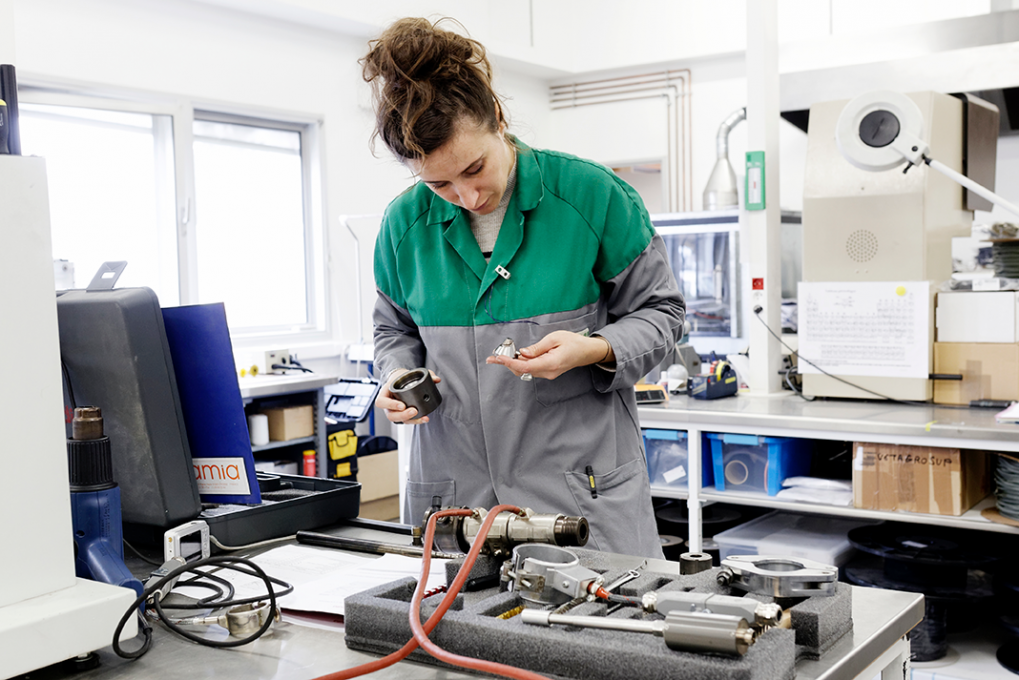Aller directement au contenu
Mechanical testing
Abrasion tests
- ISO 6722 standard test gives the number of abrasive cycle of a part until the sheath breaks.
- Renault D44-1959 standard test gives the condition of the sheath after a given cycle and temperature test.
Fatigue resistance and mechanical stress test:
- Traction test to measure the breaking force of materials, the lengthening and the Young modulus
- Fatigue test (traction cycling): Both our raw materials and products (braids, mechanical resistance of crimping, etc.) are tested.
- Shock test: In accordance with Renault-Nissan 36-05-035—C, a blade impacts the protection and cable at a defined pressure of 5J to 100J. Two dielectric stress tests follow, in accordance with standard EN5069-501.
Ageing
- Ageing through Temperature: With two ventilated autoclaves that can reach a maximum temperature of 300oC we can achieve the effects of ageing.
- Ageing using UV light: corresponding to a number years of exposure to the sun. For example, 53 hours under laboratory UV lights is equivalent to 4 years exposure to the sun.
Fire testing and propagation of flames
- Vertical and Horizontal Flame Spread Test:
Renault D45 1333 Type B Standard: gives the flammability of a product subjected to a vertical and horizontal flame. The speed of propagation as well as the length burned are measured.
- Test of flammability with incandescent wires:
NF EN60695-2-10-11 standard: a hot wire at a set temperature is placed in contact with the product for a specified time. Flammability is analysed as well as the length burnt.
- Flame persistence test, oxygen limit index assessment:
NF STANDARD IN The product is ignited and the propagation of the flame is analysed. This defines a limit index in which to maintain a persistence flame and to measure its spread. The oxygen index test involves testing the flashpoint of the product by changing the proportion of oxygen in the tube until the product ignites. Thus, the higher the oxygen index for a product, the more fire resistant it is.
Electrical test
- Current cycle test:
Measures the temperature rise due to a passage of current through a wire and is used to assess possible alterations in the mechanical and electrical properties of the product. We can talk about ageing due to the passage of current. The product’s ability to withstand the passage of the current (in the form of a spiking cycle) without degrading its electrical and mechanical properties is assessed. Corrosion may be accelerated by heat caused by the passage of a current. The degradation of the properties of the product are assessed by its ability to carry a current.
- Measurement of Linear Resistance:
Linear Resistance SetupTest: Measures the linear resistance of a product – LR (Ω.m-1), using a micro-ohmmeter the 4-wire (Kelvin) method to achieve high degree of measurement sensitivity. The micro-ohmmeter is driven by a LabVIEW program to make the data collection. The measurements are made in a controlled atmosphere at a temperature of 20 oC.
- Shielding Efficiency Test: Triaxial Method and Mode-Stirred Reverberation Chamber (MSRC)
Measurement of transfer impedance (ZT): Triaxial Setup test: CEI_62153-4-3 (2013): Conductive Resistance Test. This test is used to characterise the electromagnetic shielding performance of our products. The measure of impedance transfer ZT(Ω.m-1) is an indirect resistance test, since the test measures a rate related to product conduction based on frequency [10 kHz;100MHz]. This is directly related to the performance of the product to reduce electromagnetic waves. The lower the transfer impedance, the better the electromagnetic shielding.
- MSRC Test (Mode-stirred reverbaration chamber):
Radiated resistance test. This test measures the electromagnetic shielding efficiency of our products when subjected to homogeneous and isotropic waves of radiation manufactured by the MSRC. The lowest valid measurement frequency is limited by the size of the chamber, i.e. for our MSRC 200 MHz and the maximum frequency allowed depends on the capacity of the wavelength generator. The measurement takes place in two stages: - A mandrill with a copper core is lit by the homogeneous and isotropic wave pool. This core collects the vibrations caused by the waves.
- Then an electromagnetic shield sheath is mounted on this same copper cored mandrill. The same waves light the system composed of the shielding braid of the mandrill and the core that collects the vibrations. The efficiency of electromagnetic shielding is the dB subtraction of the test without from the test with the electromagnetic protection sheath.
- Dielectric resistance test and isolation measurement:
Dielectric resistance measures and isolation resistance of a thermoplastic material are tested according to EN50395
Physical-Chemical test
- Measure of coating thickness with the Couloscope:
This determines the thickness of the metal coatings and more precisely the tin covering the copper strands that make up part of our products with a resolution of 0.1 m. The quality of raw materials is checked upon receipt.
- Consistency and Adherence to Standard Measures of Tin (NF EN13603)
- Drop Testing: Standard (FprEN 6059-305:2018)
Tests the watertightness of coated products.

